Abstract
We investigated the effects of various assay conditions on the activity of D0870 against seven species of fungi in the broth macrodilution testing procedure proposed by the National Committee for Clinical Laboratory Standards (NCCLS). Multivariate analysis demonstrated that endpoint definition, starting inoculum size, medium composition, type of buffer, and length of incubation, but not pH or temperature, had significant effects on results. Increasing the inoculum from 10(2) to 10(5) yeast cells/ml raised the MICs for all isolates up to > 75,000 fold. This effect was greatest when endpoints corresponded to a 90% reduction in visually determined turbidity (MIC90), was less prominent with an 80% inhibition visual endpoint (MIC80), and was nearly absent with a 50% endpoint measured by a spectrophotometer (IC1/2). Differences due to medium composition were attributable to antibiotic medium 3 with RPMI and yeast nitrogen base media performing nearly identically. Under standardized conditions as specified in NCCLS document M27-P (Reference Method for Broth Dilution Antifungal Susceptibility Testing of Yeasts; Proposed Standard, 1992), 79 strains (5 to 25 strains for each species) demonstrated median MIC80s of 0.0037 and 0.0075 microgram/ml for Candida albicans and Cryptococcus neoformans, respectively. In contrast, Candida krusei and Torulopsis glabrata had a median MIC80 of 1.0 microgram/ml. Our studies indicate that the pathogenic yeasts C. albicans and C. neoformans are more susceptible to D0870 than other pathogenic yeasts.
Full text
PDF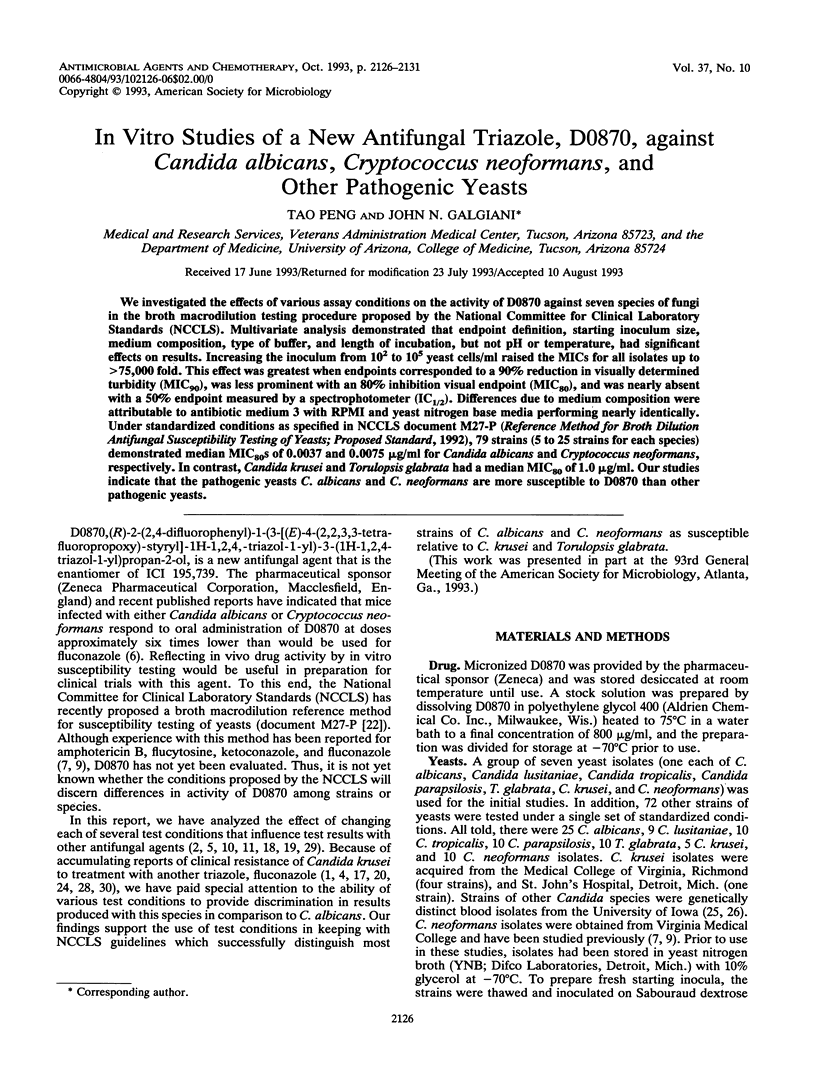
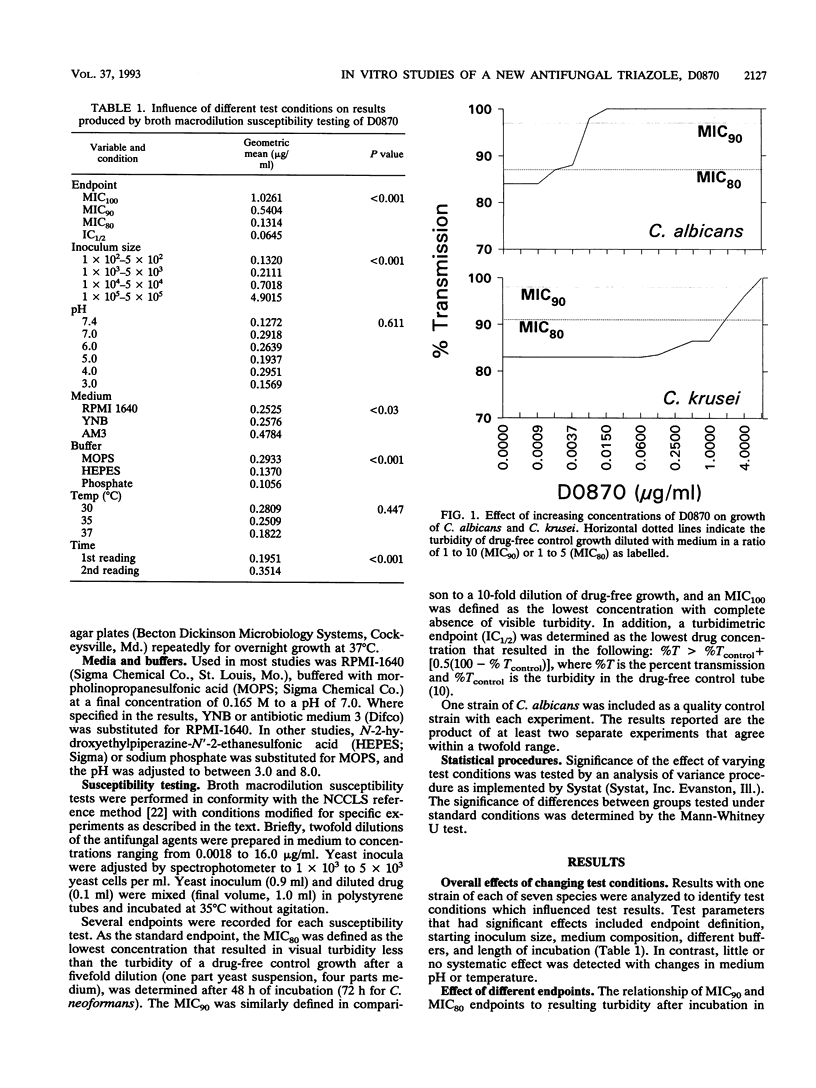
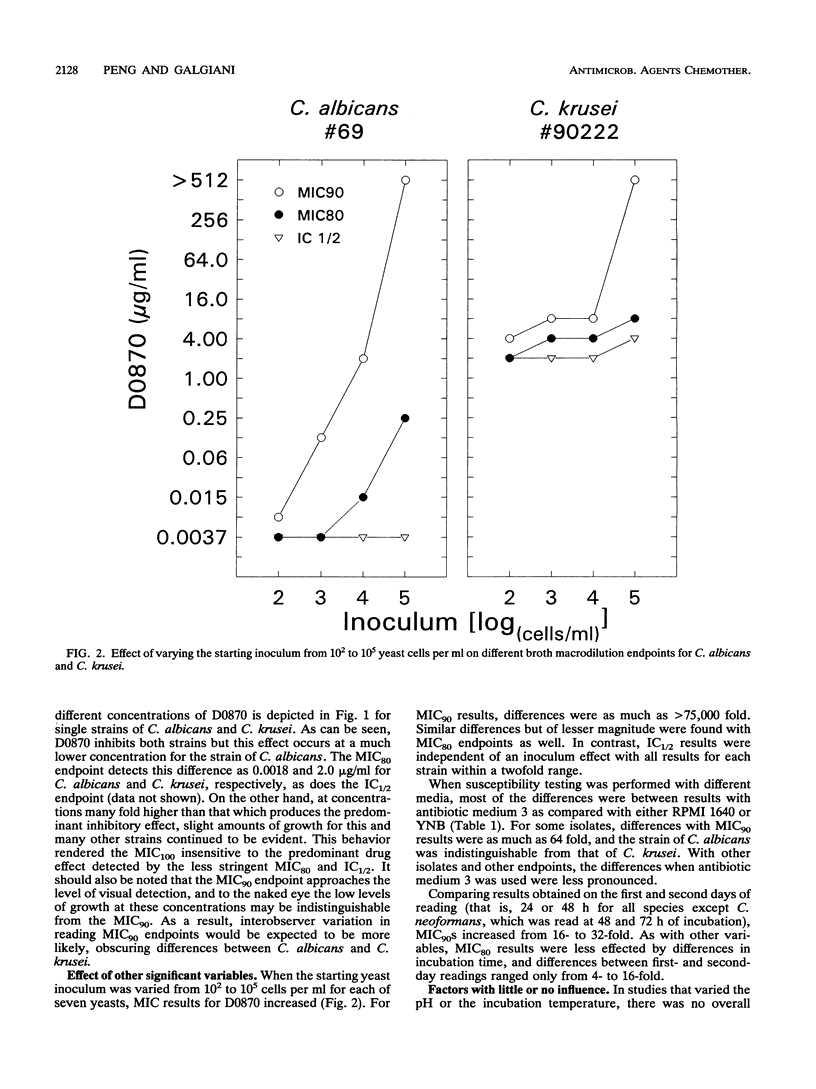
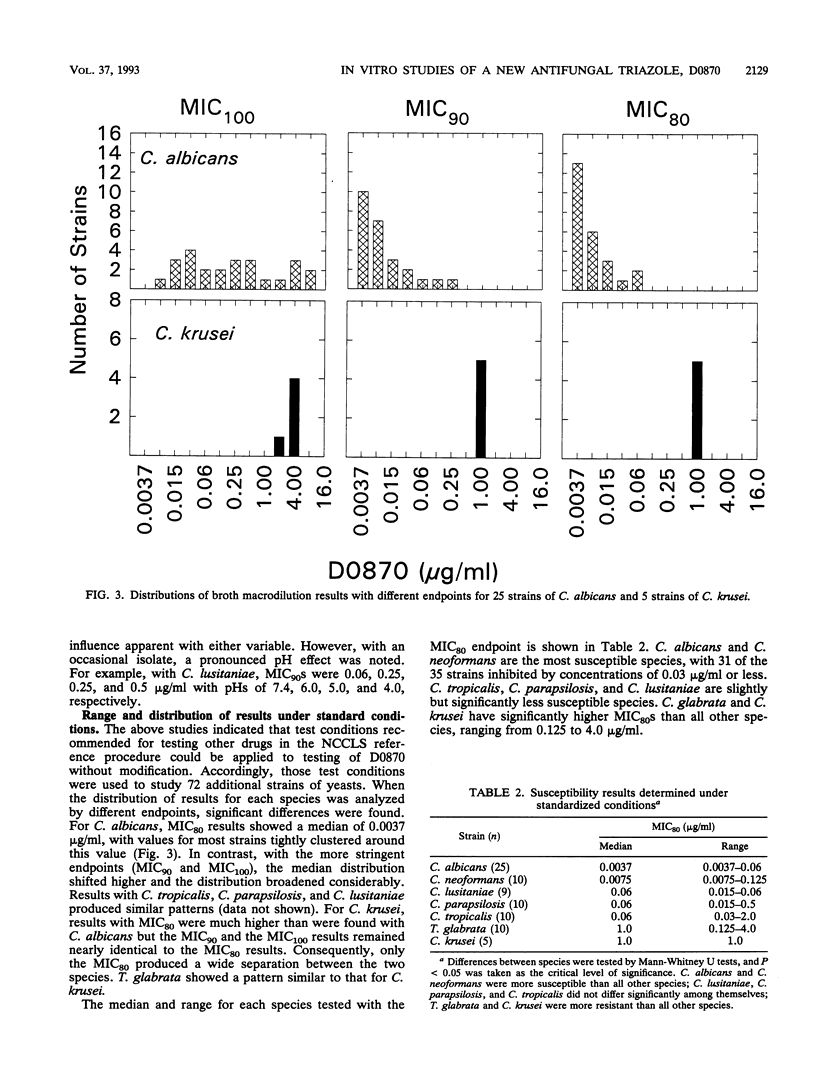
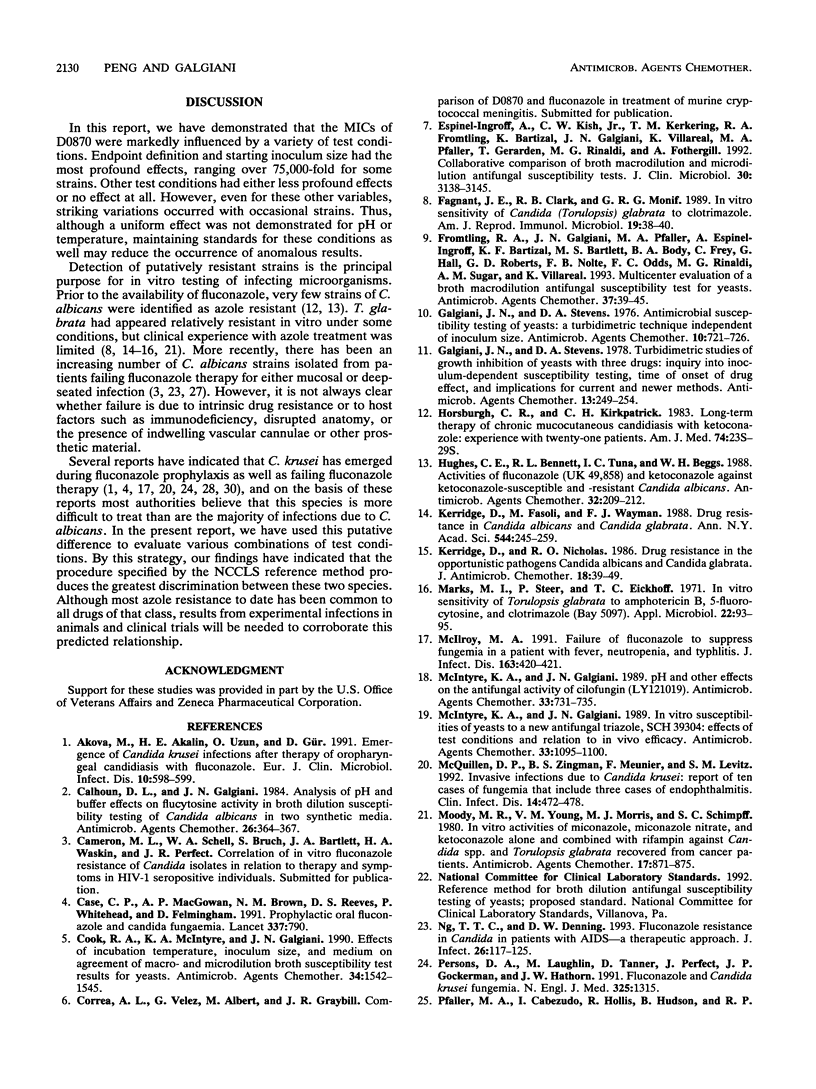
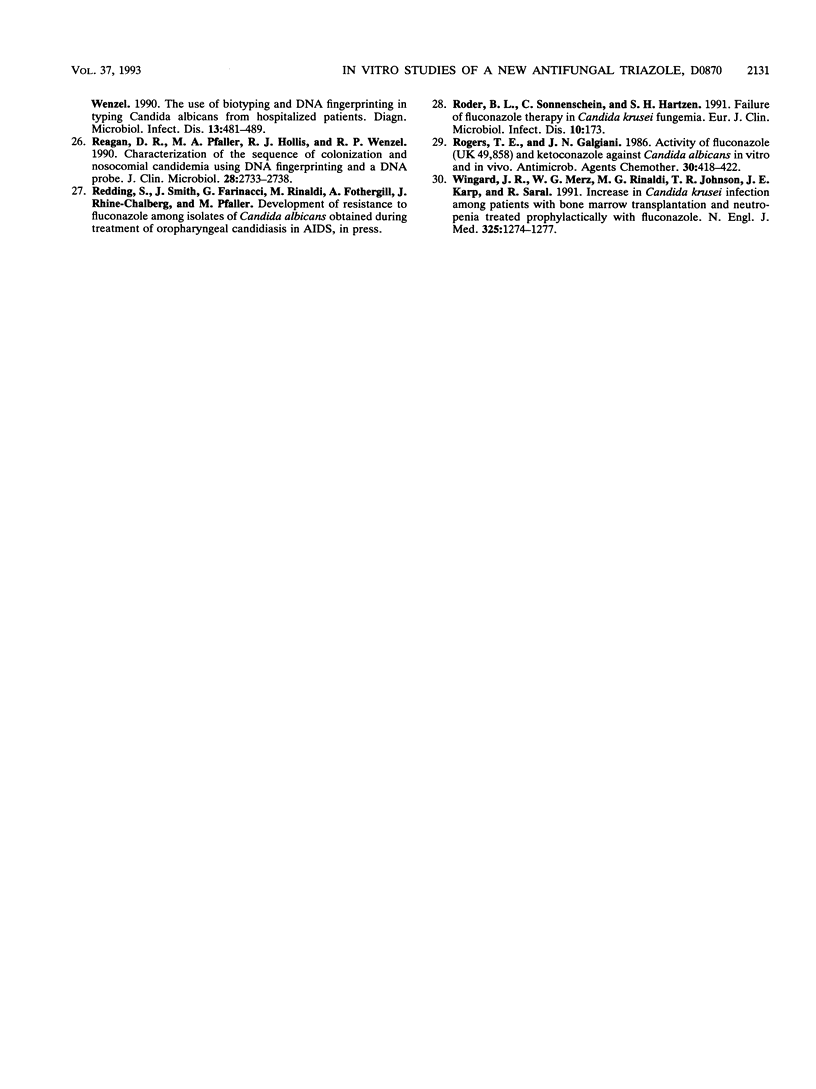
Selected References
These references are in PubMed. This may not be the complete list of references from this article.
- Akova M., Akalin H. E., Uzun O., Gür D. Emergence of Candida krusei infections after therapy of oropharyngeal candidiasis with fluconazole. Eur J Clin Microbiol Infect Dis. 1991 Jul;10(7):598–599. doi: 10.1007/BF01967286. [DOI] [PubMed] [Google Scholar]
- Calhoun D. L., Galgiani J. N. Analysis of pH and buffer effects on flucytosine activity in broth dilution susceptibility testing of Candida albicans in two synthetic media. Antimicrob Agents Chemother. 1984 Sep;26(3):364–367. doi: 10.1128/aac.26.3.364. [DOI] [PMC free article] [PubMed] [Google Scholar]
- Case C. P., MacGowan A. P., Brown N. M., Reeves D. S., Whitehead P., Felmingham D. Prophylactic oral fluconazole and candida fungaemia. Lancet. 1991 Mar 30;337(8744):790–790. doi: 10.1016/0140-6736(91)91406-k. [DOI] [PubMed] [Google Scholar]
- Cook R. A., McIntyre K. A., Galgiani J. N. Effects of incubation temperature, inoculum size, and medium on agreement of macro- and microdilution broth susceptibility test results for yeasts. Antimicrob Agents Chemother. 1990 Aug;34(8):1542–1545. doi: 10.1128/aac.34.8.1542. [DOI] [PMC free article] [PubMed] [Google Scholar]
- Espinel-Ingroff A., Kish C. W., Jr, Kerkering T. M., Fromtling R. A., Bartizal K., Galgiani J. N., Villareal K., Pfaller M. A., Gerarden T., Rinaldi M. G. Collaborative comparison of broth macrodilution and microdilution antifungal susceptibility tests. J Clin Microbiol. 1992 Dec;30(12):3138–3145. doi: 10.1128/jcm.30.12.3138-3145.1992. [DOI] [PMC free article] [PubMed] [Google Scholar]
- Fagnant J. E., Clark R. B., Monif G. R. In vitro sensitivity of Candida (Torulopsis) glabrata to clotrimazole. Am J Reprod Immunol. 1989 Jan;19(1):38–40. doi: 10.1111/j.1600-0897.1989.tb00545.x. [DOI] [PubMed] [Google Scholar]
- Fromtling R. A., Galgiani J. N., Pfaller M. A., Espinel-Ingroff A., Bartizal K. F., Bartlett M. S., Body B. A., Frey C., Hall G., Roberts G. D. Multicenter evaluation of a broth macrodilution antifungal susceptibility test for yeasts. Antimicrob Agents Chemother. 1993 Jan;37(1):39–45. doi: 10.1128/aac.37.1.39. [DOI] [PMC free article] [PubMed] [Google Scholar]
- Galgiani J. N., Stevens D. A. Antimicrobial susceptibility testing of yeasts: a turbidimetric technique independent of inoculum size. Antimicrob Agents Chemother. 1976 Oct;10(4):721–728. doi: 10.1128/aac.10.4.721. [DOI] [PMC free article] [PubMed] [Google Scholar]
- Galgiant J. N., Stevens D. A. Turbidimetric studies of growth inhibition of yeasts with three drugs: inquiry into inoculum-dependent susceptibility testing, time of onset of drug effect, and implications for current and newer methods. Antimicrob Agents Chemother. 1978 Feb;13(2):249–254. doi: 10.1128/aac.13.2.249. [DOI] [PMC free article] [PubMed] [Google Scholar]
- Hughes C. E., Bennett R. L., Tuna I. C., Beggs W. H. Activities of fluconazole (UK 49,858) and ketoconazole against ketoconazole-susceptible and -resistant Candida albicans. Antimicrob Agents Chemother. 1988 Feb;32(2):209–212. doi: 10.1128/aac.32.2.209. [DOI] [PMC free article] [PubMed] [Google Scholar]
- Kerridge D., Fasoli M., Wayman F. J. Drug resistance in Candida albicans and Candida glabrata. Ann N Y Acad Sci. 1988;544:245–259. doi: 10.1111/j.1749-6632.1988.tb40410.x. [DOI] [PubMed] [Google Scholar]
- Kerridge D., Nicholas R. O. Drug resistance in the opportunistic pathogens Candida albicans and Candida glabrata. J Antimicrob Chemother. 1986 Oct;18 (Suppl B):39–49. doi: 10.1093/jac/18.supplement_b.39. [DOI] [PubMed] [Google Scholar]
- Marks M. I., Steer P., Eickhoff T. C. In vitro sensitivity of Torulopsis glabrata to amphotericin B, 5-fluorocytosine, and clotrimazole (Bay 5097). Appl Microbiol. 1971 Jul;22(1):93–95. doi: 10.1128/am.22.1.93-95.1971. [DOI] [PMC free article] [PubMed] [Google Scholar]
- McIlroy M. A. Failure of fluconazole to suppress fungemia in a patient with fever, neutropenia, and typhlitis. J Infect Dis. 1991 Feb;163(2):420–421. doi: 10.1093/infdis/163.2.420. [DOI] [PubMed] [Google Scholar]
- McIntyre K. A., Galgiani J. N. In vitro susceptibilities of yeasts to a new antifungal triazole, SCH 39304: effects of test conditions and relation to in vivo efficacy. Antimicrob Agents Chemother. 1989 Jul;33(7):1095–1100. doi: 10.1128/aac.33.7.1095. [DOI] [PMC free article] [PubMed] [Google Scholar]
- McIntyre K. A., Galgiani J. N. pH and other effects on the antifungal activity of cilofungin (LY121019). Antimicrob Agents Chemother. 1989 May;33(5):731–735. doi: 10.1128/aac.33.5.731. [DOI] [PMC free article] [PubMed] [Google Scholar]
- McQuillen D. P., Zingman B. S., Meunier F., Levitz S. M. Invasive infections due to Candida krusei: report of ten cases of fungemia that include three cases of endophthalmitis. Clin Infect Dis. 1992 Feb;14(2):472–478. doi: 10.1093/clinids/14.2.472. [DOI] [PubMed] [Google Scholar]
- Moody M. R., Young V. M., Morris M. J., Schimpff S. C. In vitro activities of miconazole, miconazole nitrate, and ketoconazole alone and combined with rifampin against Candida spp. and Torulopsis glabrata recovered from cancer patients. Antimicrob Agents Chemother. 1980 May;17(5):871–875. doi: 10.1128/aac.17.5.871. [DOI] [PMC free article] [PubMed] [Google Scholar]
- Ng T. T., Denning D. W. Fluconazole resistance in Candida in patients with AIDS--a therapeutic approach. J Infect. 1993 Mar;26(2):117–125. doi: 10.1016/0163-4453(93)92707-4. [DOI] [PubMed] [Google Scholar]
- Persons D. A., Laughlin M., Tanner D., Perfect J., Gockerman J. P., Hathorn J. W. Fluconazole and Candida krusei fungemia. N Engl J Med. 1991 Oct 31;325(18):1315–1315. [PubMed] [Google Scholar]
- Pfaller M. A., Cabezudo I., Hollis R., Huston B., Wenzel R. P. The use of biotyping and DNA fingerprinting in typing Candida albicans from hospitalized patients. Diagn Microbiol Infect Dis. 1990 Nov-Dec;13(6):481–489. doi: 10.1016/0732-8893(90)90080-f. [DOI] [PubMed] [Google Scholar]
- Reagan D. R., Pfaller M. A., Hollis R. J., Wenzel R. P. Characterization of the sequence of colonization and nosocomial candidemia using DNA fingerprinting and a DNA probe. J Clin Microbiol. 1990 Dec;28(12):2733–2738. doi: 10.1128/jcm.28.12.2733-2738.1990. [DOI] [PMC free article] [PubMed] [Google Scholar]
- Rogers T. E., Galgiani J. N. Activity of fluconazole (UK 49,858) and ketoconazole against Candida albicans in vitro and in vivo. Antimicrob Agents Chemother. 1986 Sep;30(3):418–422. doi: 10.1128/aac.30.3.418. [DOI] [PMC free article] [PubMed] [Google Scholar]
- Røder B. L., Sonnenschein C., Hartzen S. H. Failure of fluconazole therapy in Candida krusei fungemia. Eur J Clin Microbiol Infect Dis. 1991 Mar;10(3):173–173. doi: 10.1007/BF01964453. [DOI] [PubMed] [Google Scholar]
- Wingard J. R., Merz W. G., Rinaldi M. G., Johnson T. R., Karp J. E., Saral R. Increase in Candida krusei infection among patients with bone marrow transplantation and neutropenia treated prophylactically with fluconazole. N Engl J Med. 1991 Oct 31;325(18):1274–1277. doi: 10.1056/NEJM199110313251803. [DOI] [PubMed] [Google Scholar]


